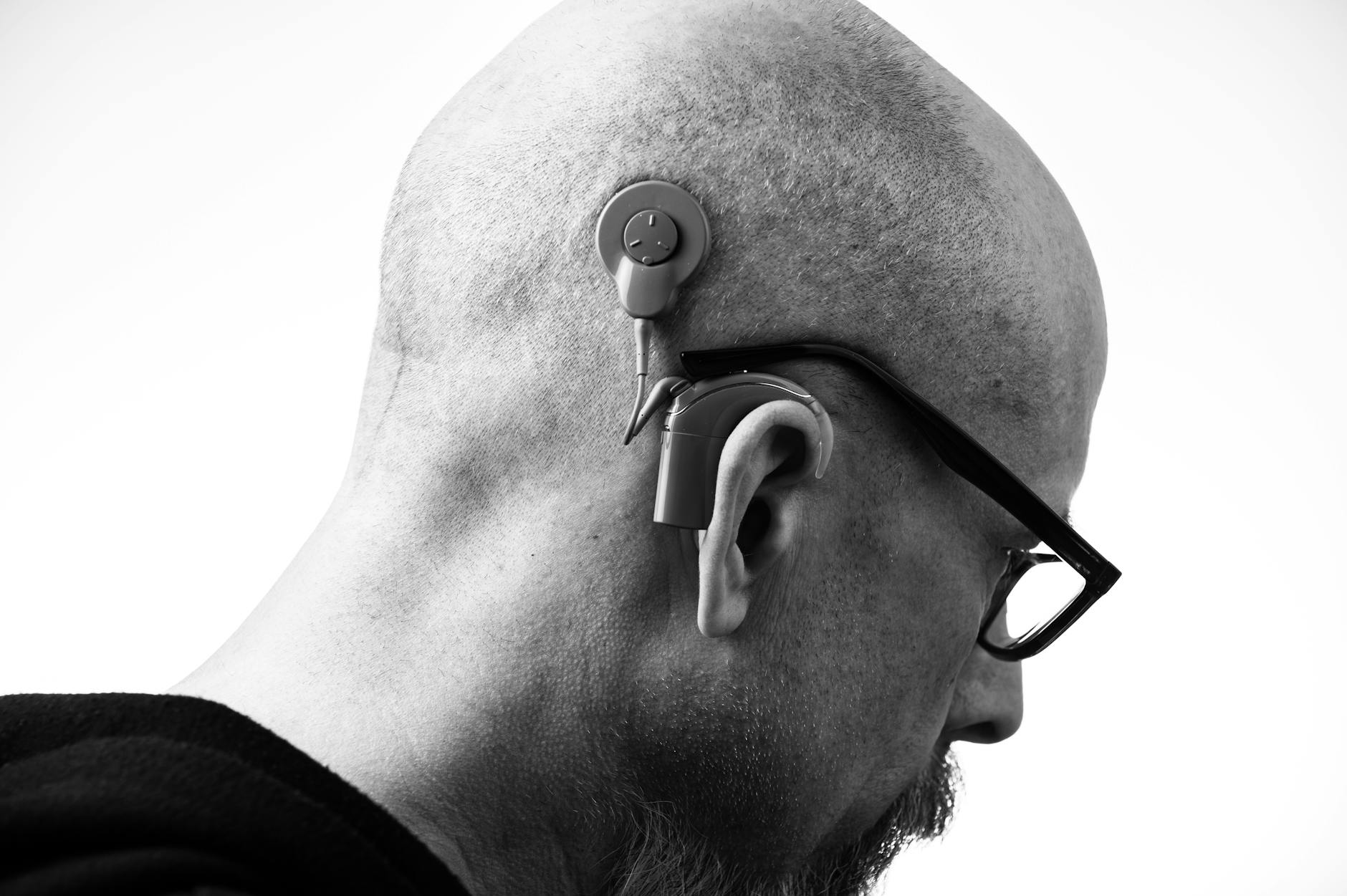Ever leave a restaurant feeling like you just ran a mental marathon? You’re not alone. Even the smartest hearing aids struggle when noise and distance pile up. The quiet superpower almost nobody talks about: put the microphone on the person you want to hear. That’s exactly what remote microphones do—and the clarity boost can feel like magic.
Why Noisy Places Feel Impossible (Even with Great Hearing Aids)
Let’s quickly demystify the physics. Understanding the problem makes the solution feel obvious:
- Distance kills clarity. Sound drops fast with distance. Double the distance from the talker and their voice can fall by roughly 6 dB, while background noise stays put. That erodes the signal-to-noise ratio (SNR)—the single most important ingredient for speech understanding.
- Noise piles up. Cafés, meetings, gyms, classrooms—every extra talker and clinking dish adds competing sound that your brain must “unmask.”
- Rooms echo. Hard surfaces create reverberation that smears speech cues. Even perfect ears hate it; hearing devices can’t fully un-scramble echoes.
Directional microphones and noise reduction in hearing aids help, often adding 2–5 dB of SNR. But when the talker is far away or the room is chaotic, that’s not enough. The best fix is ancient and simple: move the microphone closer to the mouth you care about.
What Is a Remote Microphone?
A remote microphone (often called a remote mic, RM, or Roger/DM/FM mic) is a small, wireless mic that clips to a talker’s clothing or sits on a table. It streams their voice directly to your hearing aids, cochlear implants, or headphones—leapfrogging noise, distance, and echo.
The Main Players
- Lapel/clip-on mic: Pins near a speaker’s collar for one-to-one conversations, lectures, tours, or fitness classes. Super clear because the mic is inches from the mouth.
- Table mic: Sits in the middle of a group. Uses beamforming (steers its “ears” toward the person talking) to highlight whoever is speaking. Some are pass-around mics for meetings.
- Handheld/pass-around: Great for Q&A. The person holding the mic “owns” the floor; everyone hears clearly.
- Presenter/teacher systems (DM/FM): Designed for classrooms and workplaces; often network multiple mics so you hear the teacher and classmates.
- Phone-as-mic options: Your smartphone can act like a simple remote mic. On iPhone, Live Listen with MFi hearing aids or AirPods; Android has Sound Amplifier features. Not as polished, but handy and inexpensive.
How Remote Mics Connect (and Why It Matters)
Connectivity shapes sound quality, lag (latency), and ease of use:
- Proprietary 2.4 GHz/DM systems (e.g., Roger): Ultra-reliable, low latency, designed for speech. Often require matching receivers (built into certain hearing aids/implants or added via a small shoe/boot, clip-on receiver, or neckloop).
- Made for iPhone (MFi) / ASHA (Android) direct streaming: Allows phone-based remote mic apps and direct audio to compatible hearing aids. Convenience is the win here; latency is usually fine for conversation.
- Bluetooth Classic and LE Audio: Some table mics and streamers use standard Bluetooth to send audio to a pendant/streamer or directly to earbuds. LE Audio with LC3 codec improves battery life and latency; venue “broadcast” features (Auracast) are rolling out, but personal mics remain the most reliable way to hear a specific talker.
- Telecoil neckloops: A mic transmits to a neckloop, which sends a magnetic signal to your hearing aid’s telecoil. Simple, compatible with many devices, and helpful in looped venues.
Ask your audiologist which options play nicely with your current hearing aids or implants—and what add-ons you might need.
How Big Is the Benefit?
Short answer: big enough to change your social life. Remote mics can provide substantial SNR gains by bypassing room noise and narrowing the microphone-to-mouth distance. Clinical studies and professional guidelines report meaningful improvements in speech understanding in noise when remote microphones are used compared with hearing aids alone, especially in classrooms and restaurants. Many users perceive the difference as the moment when conversation clicks into place rather than blurs.
Translating the tech to real life:
- One-on-one in noise: Clip a lapel mic on your dinner companion. Suddenly, their words pop above the room.
- Small groups: Use a table mic that auto-steers to the active talker. You’ll follow the conversation with less effort.
- Talks/lectures: A presenter mic feeds their voice directly to you, even from the back row.
- Hybrid meetings: Place the mic by the conference speaker; combine with captions for a powerful 1–2 punch.
Everyone’s hearing and listening environments are different, so expect some trial and error. Your best bet is to demo with your audiologist and compare situations with and without the mic.
Choosing the Right Remote Mic
Start with compatibility
- Your devices: Which hearing aids or cochlear implants do you use? Some brands have dedicated mics; others work via a universal receiver, neckloop, or phone app.
- Streaming path: Direct to aids, through a streamer/pendant, or via your phone. Fewer hops usually means simpler setup and lower latency.
Match the mic to your life
- Mostly one-on-one? Get a small lapel mic you can clip on a friend or trainer.
- Frequent group meals or meetings? Choose a table mic with beamforming and “multi-talker” modes.
- Presentations or classes? Look for a presenter mic and consider systems that daisy-chain multiple microphones.
- Active lifestyles? Prioritize battery life, pocketability, and a mute button.
- Budget-friendly? Try phone-as-mic features first, then upgrade to dedicated hardware if you love the effect.
Helpful features to compare
- Beamforming quality: How well does it focus on the talker and reject clatter?
- Latency: Lower is better, especially if you also hear the person acoustically.
- Range and reliability: Will it work across a classroom or a big dining room?
- Battery life and charging case: Aim for all-day confidence.
- Mute and privacy controls: Essential for etiquette.
- Accessory ecosystem: Can you add more mics later? Integrate with TVs, laptops, or conference gear?
Setup, Etiquette, and Real-World Tricks
Make it comfortable for you and your conversation partners:
- Clip placement: For lapel mics, 6–8 inches below the mouth, away from scarves/jewelry to avoid rustle.
- Table mic position: Center of the group, on a stable surface. Avoid directly under loud speakers or near clattering dishes.
- Explain the “why” in one sentence: “This tiny mic helps me hear you clearly in noise—it streams your voice right to my ears.” People are usually happy to help.
- Use the mute button: Remind your talker they can mute during a private aside or a bathroom break. You can also switch inputs quickly on most hearing aids.
- Reduce competing noise: Turn off background music, close a door, or sit with your back to noise when possible.
- Pair with captions: Live caption apps (on phones, tablets, laptops) plus a remote mic is a powerful combo for meetings.
- Carry a clean pouch: Keep the mic safe, charged, and lint-free. Label it with your name.
Cost, Access, and Try-Before-You-Buy
Remote mics range from budget-friendly phone-based options to premium dedicated systems. Prices vary widely based on brand and whether you need receivers. Funding may be available through schools, vocational rehabilitation, disability services, or workplace accommodations. Some clinics offer loaners or in-office demos—ask to test in a mock noisy setup or take one for a trial meal.
If your budget is tight, start with your smartphone’s built-in assistive features to see how moving the mic changes your experience. If you like it, you’ll love a dedicated device.
Limitations to Keep in Mind
- Handling noise: Clothing rub and table bumps can be loud; placement matters.
- Echo caverns: In very reverberant rooms, lapel mics still help, but table mics may struggle if everyone is far from the mic.
- Battery management: You’ll need to charge another device—build it into your routine.
- Etiquette and privacy: Always ask before clipping a mic on someone, and reassure them about mute controls.
Quick Start: Your First Remote Mic Game Plan
- Pick a priority situation: Noisy dinners? Weekly staff meeting? Start there.
- Try a phone-as-mic trial: Put your phone in front of the talker and stream to your aids or earbuds. Notice the change.
- Book an audiology demo: Test a lapel mic and a table mic with your current devices. Compare clarity and comfort.
- Practice the social script: “Would you mind clipping this tiny mic? It helps me hear you really clearly.” Keep it light and appreciative.
- Refine the setup: Adjust placement, volumes, and modes. Add captions for meetings.
If you routinely avoid places you used to love because of noise, a remote mic can be the single most impactful add-on to your hearing setup. An audiologist can help you choose a model, verify compatibility, and fine-tune settings so your brain gets the cleanest possible signal.
What’s Next: Personal Mics Meet Smarter Audio
Emerging Bluetooth LE Audio features are making it easier to receive high-quality, low-latency streams from phones and computers. Venues are beginning to add broadcast audio, but for personal conversations, nothing beats physically moving the microphone closer to the talker. That simple move is timeless—and it just works.
Gentle Reminder
Hearing challenges in noise can have many causes. If you’re struggling, consider a comprehensive hearing evaluation and a conversation with an audiologist. They can recommend the right tech mix—hearing aid settings, remote microphones, and communication strategies—to help you hear with less effort.
Further Reading
- Auracast Is Coming: How Bluetooth LE Audio Will Transform Hearing in Public Places (Technology) - Milliseconds Matter: Hearing Aid Latency, Echoey Voices, and Faster Fixes (Technology) - Your Phone, a Super Mic: Cleaner Conversations with Remote Microphone Mode (Technology) - Sound Ergonomics for Remote Work: Hear Clearly, End the Post‑Zoom Exhaustion (Lifestyle)Frequently Asked Questions
Will a remote microphone help if I don’t wear hearing aids?
Possibly. You can use a phone as a remote mic and listen with high-quality headphones or earbuds. Some dedicated remote mics can stream to consumer earbuds via Bluetooth. That said, if hearing loss is involved, professionally fitted hearing aids or cochlear implants plus a remote mic typically provide the best clarity and comfort. An audiologist can help you compare options.
How is a remote mic different from the directional mics in my hearing aids?
Directional mics in hearing aids help, but they’re still on your ears—several feet from the talker and surrounded by noise. A remote mic sits inches from the mouth you care about. That proximity dramatically improves the signal-to-noise ratio, which your brain experiences as clearer, easier speech.
What about latency—will the sound feel out of sync?
Most modern systems designed for speech keep latency low enough that it feels natural. Proprietary DM/2.4 GHz systems and direct smartphone streaming to compatible hearing aids are usually comfortable. If you notice echo or delay, your audiologist can adjust mixing or recommend a lower-latency path.
Is it rude to ask someone to wear a mic?
Most people are glad to help once they know it makes conversation easier for you. Keep it simple: “This tiny mic streams your voice to my hearing aids so I can follow you clearly.” Offer the mute button for privacy and thank them. In group meetings, a table mic or pass-around mic feels very natural.



